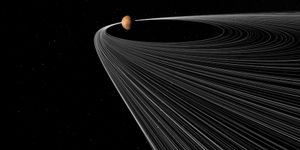Astrophysicists Map Evolution of Binary Stars Using White Dwarf and Main Sequence Pairs
What can binary stars comprised of two different types of stars teach astronomers about stellar evolution? This is what a recent study published in The Astrophysical Journal hopes to address as a team of researchers from the United States and Canada investigated a binary star system comprised of white dwarfs and main sequence stars that could challenge longstanding notions regarding binary systems and help astronomers gain greater insight into stellar evolution throughout the cosmos.
“Binary stars play a huge role in our universe,” said Steffani Grondin, who is a PhD Candidate in the David A. Dunlap Department for Astronomy & Astrophysics at the University of Toronto and lead author of the study. “This observational sample marks a key first step in allowing us to trace the full life cycles of binaries and will hopefully allow us to constrain the most mysterious phase of stellar evolution.”
For the study, the researchers combined observational datasets from retired and active telescopes and machine learning to search and identify binary systems containing main sequence stars and white dwarfs within 299 open star clusters in our Milky Way Galaxy. In the end, the researchers identified 50 binary candidates, which builds on only two previous candidates identified in past studies, along with them existing across 38 star clusters throughout the Milky Way. It is hypothesized that these star clusters formed and evolved simultaneously, indicating these binary systems containing main sequence stars and white dwarfs could help astronomers put constraints on the ages of these star clusters.
“It really points out how much in our universe is hiding in plain sight – still waiting to be found,” said Dr. Maria Drout, who is a professor in the David A. Dunlap Department for Astronomy & Astrophysics at the University of Toronto and a co-author on the study. “While there are many examples of this type of binary system, very few have the age constraints necessary to fully map their evolutionary history. While there is plenty of work left to confirm and fully characterize these systems, these results will have implications across multiple areas of astrophysics.”
While our Sun is considered a main sequence star that is “alive” given its active fusion process that converts hydrogen into helium, white dwarf stars are considered “dead” stars as they have exhausted their hydrogen and ceased to perform nuclear fusion. As a result, they have shed their outer layers after transforming into a reg giant, leaving a small and dense star that is a remnant of a main sequence star like our Sun. While binary stars have traditionally been observed to contain two stars of similar types, either “alive” or “dead”, this new study helps shed light on binary systems and what this could mean for better understanding stellar evolution, overall.
What new discoveries about binary star systems will researchers make in the coming years and decades? Only time will tell, and this is why we science!
As always, keep doing science & keep looking up!
Sources: The Astrophysical Journal, EurekAlert!, Wikipedia, Wikipedia (1)
Featured Image: The binary star system, HD101584. (Credit: ALMA (ESO/NAOJ/NRAO), Olofsson et al. Acknowledgement: Robert Cumming)








